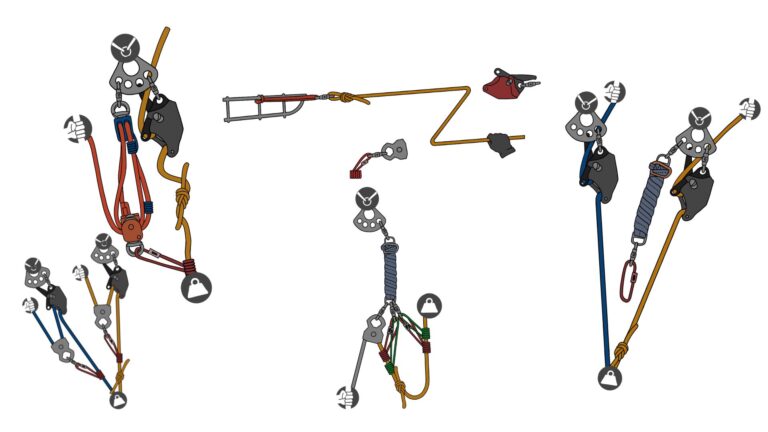Mechanical Advantage Systems in Rescue Operations: The Role of Pulleys and Progress Capture Devices
In the world of rescue operations, pulleys and progress capture devices (PCDs) play essential roles in ensuring safety, control, and efficiency. Pulleys redirect and multiply forces, making lifting possible with reduced effort, while PCDs ensure that the load remains stable, preventing it from slipping back. This third part of our series focuses on the types of pulleys, PCDs, and how they integrate into mechanical advantage (MA) systems for reliable, controlled rescue operations.
The Central Role of Pulleys in MA Systems
Pulleys are fundamental components of MA systems, providing two key functions: directing the pulling force and multiplying it where needed. Choosing the right type of pulley for a system depends on the specific demands of the rescue scenario.
Types of Pulleys
- Fixed Pulleys: These pulleys are anchored in place and primarily serve to redirect the pulling force. By changing the force’s direction without adding mechanical advantage, fixed pulleys are ideal for creating smooth, controlled pathways for the rope.
- Movable Pulleys: Unlike fixed pulleys, movable pulleys are attached directly to the load and move along with it. These pulleys provide mechanical advantage by reducing the amount of force required to lift the load. For example, a single movable pulley can create a 2:1 mechanical advantage, significantly reducing the effort needed to lift heavy weights.
Progress Capture Devices (PCDs)
In addition to pulleys, progress capture devices are critical for maintaining control and safety within an MA system. PCDs prevent loads from slipping back, which is essential for maintaining progress during lifts or moves. Two common types of PCDs used in rescue operations are:
- Prusik Knots: A Prusik knot is a type of friction knot that tightly grips the rope under load, providing a natural way to capture progress. It holds fast when loaded and can slide when unweighted, making it a reliable, low-tech option for progress capture.
- Mechanical Ascenders: Mechanical ascenders are devices designed to allow rope movement in one direction while locking in the opposite. These devices offer a smoother, more controlled capture than knots, especially useful in complex or prolonged rescues where precise control over load movement is critical.
Integrating Pulleys and PCDs in Mechanical Advantage Systems
When integrated correctly, pulleys and PCDs enable safe, efficient, and controlled operations within MA systems. Here’s how they contribute to operational success:
- Safety: PCDs play a crucial role in maintaining progress and preventing accidental load slippage, ensuring that once a load is lifted, it stays in place. This is particularly important in multi-stage lifts or in situations where conditions could disrupt stability.
- Efficiency: Using pulleys that reduce friction and PCDs that ensure steady movement allows rescuers to lift and lower loads smoothly. By maintaining a controlled pace, teams can avoid sudden jerks or shifts that could compromise safety or system integrity.
Conclusion
Mastering the use of pulleys and progress capture devices is essential for rescue professionals seeking to improve the efficiency and safety of mechanical advantage systems. From understanding the distinctions between fixed and movable pulleys to knowing how to apply friction knots and mechanical ascenders, integrating these components correctly can elevate the effectiveness of rescue operations.
Choosing the appropriate system, incorporating the right pulleys, and applying reliable progress capture devices are all part of a comprehensive rescue strategy. With continued training and practice, rescuers can build confidence and competence in applying these critical tools in real-world scenarios. For more detailed training on MA systems and equipment, explore our resources at Rigging Lab Academy.
5 Rules to Help Determine Simple & Compound Mechanical Advantage Systems
Peace on your Days
Lance









